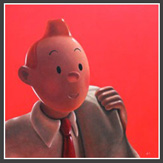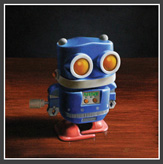Thu 21 Feb 2013
More Dust
Posted by anaglyph under Love, Nostalgia, Sad
[3] Comments

And now nine whole years have passed. It’s a strange and sad universe. Rest in peace KPop.
Thu 21 Feb 2013
Posted by anaglyph under Love, Nostalgia, Sad
[3] Comments

And now nine whole years have passed. It’s a strange and sad universe. Rest in peace KPop.
Tue 21 Feb 2012
Posted by anaglyph under Love, Nostalgia, Sad
[3] Comments
Mon 10 Oct 2011
Posted by anaglyph under Love, Nostalgia, Science
[4] Comments

Since we’ve been speaking of apples, death and pancreatic cancer, here’s a photograph that my friend Adrienne sent me a couple of days ago. This is the Newton apple tree that I planted with the ashes of my beloved Kate, lovingly tended in its Blue Mountains home.
Fri 7 Oct 2011
Posted by anaglyph under Gadgets, Geek, In The News, Love, Nostalgia, Sad, Technology
[95] Comments

I hate computers. I hate them in the same way as I hate audio equipment. For me, gadgets have always been a means to an end. My idea of the perfect audio system is one with no wires, no speakers, no knobs and no disks. All that stuff is ugly and distracting. I would be happy if I could just go into my favourite room and hear the music without any need for the accompanying paraphernalia.
And my idea of a perfect computer is one with no hard drives, no interfaces, no file systems, no processors. I don’t really care that something has 3 terabytes of RAM or a 16GHz processor. And the big humming boxes that house such things are ugly, distracting and hot. My idea of a perfect computing environment is one with nothing more than a screen, a sketchpad, and a keyboard ((I still like typing over writing, and for the short term at least I don’t see any alternative to a keyboard. When voice recognition becomes MUCH better, maybe it will be nice to speak things to your computer, but as long as we read, I think there will be writing of some kind. Perhaps that will change when direct neural interaction becomes possible…)) and where I can do stuff and get results without having to think about file management or disk fragmentation or syntax or communications protocols.
The last few days have seen a lot of discussion about the sad passing of Steve Jobs and the legacy he has left the world. There can be little doubt, even among the detractors, that his vision did change our modern lives in a most profound way. To deny it is to be trivially contrarian. For me, the greatest thing for which Steve ((It’s funny how I feel quite comfortable calling him Steve. In my circles it’s always been the way. I think he has been such a big influence in our daily lives that I feel, like a lot of people I guess, that I kinda knew him personally.)) is responsible is not the Mac, nor the iPod, the iPad or the iPhone, ((I’ve always detested that pretentious and irksome ‘i’ prefix…)) but the wondrous behind-the-scenes tech of the operating systems in all those gadgets.
Some of you are probably old enough to remember the kinds of computing devices that existed before the Apple Macintosh came along and changed the computing world forever. I had two of them: a Commodore 64 and an Atari ST. You communicated with the Commodore via BASIC ((The C64 had no operating system as such, hard as that is to comprehend these days. When you booted it, it was just a dumb blank brain until you loaded something into its RAM.)) and with the Atari via Atari DOS, neither of which were what you could remotely consider ‘intuitive’. Each of these devices required a significant amount of figurin’ if you wanted to get something useful done with them. There certainly wasn’t much need to own one unless you intended to do something that was, in those days, fairly obscure, like music sequencing or database building.
I believe that Steve Jobs greatest gift to us was to make the ‘computeriness’ of computers go away (well, at least to start making it go away – it’s still not as invisible yet as I would like personally). I think that Jobs understood in his bones that most people don’t have the remotest desire to want to tangle with computers. They just want to do stuff. They just want to have their whole music collection to choose from when they’re taking a walk. They just want a little game to play while they’re waiting for the train. They just want to snap pictures and send them to a friend – or make them into a photo album. They just want to be able to lie in bed and browse the web.
And, when they work, they just want to be able to write a letter, prepare a report, record a song, edit a movie or hold a video conference without having to understand what C+ or printer drivers or ROM or RAM or SCSI or serial ports are. Mr Jobs took us a long way along the path to never having to think about this kind of ephemera and to just getting on with doing the things we needed (and wanted) to do.
I admit, quite proudly, to being what is derogatorily known these days as an Apple fanboy. I bought my first Apple product, a Mac Plus, in 1988, and not long that after switched up to an SE. After the Atari it was like upgrading from a badly-tuned 2 cylinder motor scooter to a Rolls Royce. I was initially only interested in having a computer solely as a music tool, but with the Macintosh, suddenly I could do all this other stuff as well. It was truly an enlightening experience. The thing that captured my imagination most of all with those early Macs was that for my mind, at least, they just felt right. It was like there was someone sensible in the design process who was thinking more about me and how I might want to use the machine, than whether it had the latest chipset or the fastest clock speed. That someone was Steve Jobs. In short, I felt an immediate affinity with the Macintosh because it didn’t get in the way of what I wanted to do with it.
Advocates of PCs and the Microsoft Windows way of doing things (and to a lesser extent aficionados of worthy alternatives like Linux), can’t understand why we Apple disciples love our Apple environments so much. They look on the Apple culture as something like a fashion trend, believing us to have all been sucked in by the slick design and the tinker-toy simplicity of the computers themselves. They frequently proclaim that we have ‘drunk the Cool Aid’. What they fail to understand is that people like me simply don’t care that there are faster, cheaper, more efficient, cleverer ways to do computer things out there; ((Consider these two options: 1. An ugly car that has a theoretical speed of 300 mph, has a super-efficient engine, an optimized drive-train and is technically superior to every other car on the road – as long as you fully understood the complicated procedure for driving it; 2. A nicely designed car that reliably gets you to the shops and back without any thought on your part about how that’s achieved. Some people will undoubtedly choose the first option. People whose main concern is just getting the shopping done will be the same people who buy a Mac.)) to us, computers are necessary annoyances, and the simpler it is to get something done with them, and the less they force you to think ‘like a computer’, the better. ((In this respect, Apple’s ‘Think Different’ campaign is not so much about how people think about the world, but about how the world was thinking about computers. Apple was truly thinking different(ly).)) This was the critical insight of Steve Jobs – an insight that went on to inform the Apple music players, the phones, the tablets and the online stores. We love Apple, and we loved Steve, because he made our lives richer by giving us the power of computers without needing to be part of the arcane secret societies that had previously been the sole interlocutors for the mysterious digital magicks. This, I believe, is what the PC (and IT) crowd hate most about Apple – that it has given the peasants the keys to the church.
One of the criticisms you hear most from Apple critics is that Jobs pushed ‘style-over-substance’. This is mostly a cry of ‘How come we can’t make OUR things so neat?’, because if you think about it, how can anyone celebrate a lack of style? The real implication of this complaint is, of course, that if there is style there must necessarily be little substance. Such a deprecation indicates the profound absence of acumen of the prosaic mind. As any thinking person should realise, style is not just an outer layer in which something is cloaked, but is an integral part of its very being. To quote Jean-Luc Godard:
To me style is just the outside of content, and content the inside of style, like the outside and the inside of the human body. Both go together, they can’t be separated.
The style with which Jobs imbued Apple products is not surface deep, but reaches down into the core of the Apple brand. It is his personal philosophy that we engage with every day when we use our iPods and iPhones, our iPads and iMacs. We believe that Steve understood exactly how to allow us to engage with the world in a way that felt stylish and empowering and fun and, well, yes, insanely great.
It is for this reason, I believe, that even though we didn’t know him personally, many of us long-time and dedicated Apple users feel very deeply that with his untimely death we’ve lost a dear friend. And we fear that the people who are now taking over the reins at Apple might not truly understand what Steve Jobs seemed to embody intuitively as a driving force. Certainly, there is currently no-one else in the tech world who does, even including the very closely philosophically aligned Sergey Brin and Larry Page.
Perhaps that’s the way it happens. I guess that’s for history to judge. For now, Steve Jobs has planted the seeds of great ideas. We can only hope that they continue to grow into beautiful trees without him to tend them.
Rest in peace Steve. I, for one, am richer for having had my life illuminated by the tools and creative philosophies which you brought us.
Sat 16 Jul 2011
Posted by anaglyph under Art, Nostalgia
[6] Comments
My good friend Nick Stathopoulos is exhibiting the second in his Toy Porn series – paintings of the toys we know and love from childhood. If you’re in Sydney, you should really go along and see them in the flesh… er… in the acrylic. I’ve seen some of the first series at firsthand: they are truly beautiful artworks.
July 26 – August 13
NG Art Gallery
Upper Level
3 Little Queen Street
Chippendale NSW 2008
Sydney Australia



The paintings are all for sale, but I hear they’re being snapped up fast. Damn you empty piggy bank!!!
Thu 30 Jun 2011
Posted by anaglyph under Art, Cow Matters, Nostalgia, Words
[5] Comments

Or, How To Get Product Placement on Tetherd Cow Ahead Without Even Trying
A couple of weeks back I told you the story of the tragic event in my youth that undoubtedly thwarted a brilliant artistic career; namely the loss of my beautiful set of Derwent pencils. To my surprise, the charming Rebecca from Derwent in the UK read that post and kindly offered to send me some Derwents, which I’m pleased to report she did. They arrived in the post a few days ago.
The look of the pencils has changed somewhat – gone are the rainbow hues, replaced with an earthy brown with colourful tips (they’re not really blue like they appear in the arty HipstaMatic ((Dang. Secondary product placement! I should be getting kickbacks!)) shot above). I’m pleased to say, though, that the pencils themselves retain their waxy luxury and I aim to take a little outing somewhere over the next few weeks, to sit and draw, something I have not done in many years.
Wherever I venture, you can be sure that this time I will not leave my Derwents on the bus.
Thank you Rebecca, for the lovely coda to my childhood story.